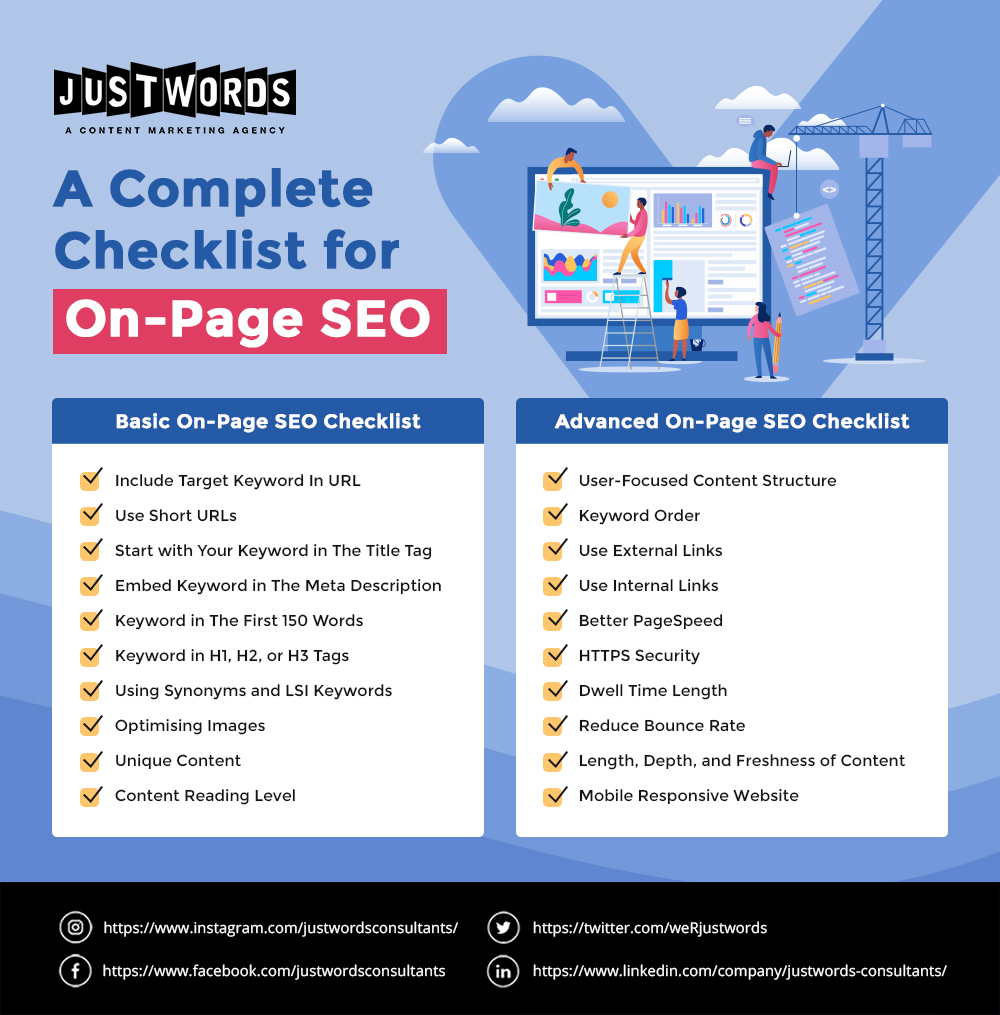As long as there are search engines, businesses will be interested in achieving the top ranks and growing their traffic. It has been the case for the last many years, and the trend doesn’t seem to fade away anytime soon.
Although there have been many twists, turns, ups, and downs in the SEO techniques, the one thing that remained constant throughout the years is the on-page SEO. But that doesn’t mean it hasn’t evolved? So, whether you are just brushing up your skills to get up-to-date with SEO techniques or a complete newbie to the SEO world, here is the on-page SEO checklist for you.
Table of Contents
Basic On-Page SEO Checklist
1. Include Target Keyword In URL
Let’s start from the very first thing that Google notices about your page – the URL. Your URL helps Google in understanding what the page is about. When you add a target keyword in the URL, it improves your organic CTR.
Let’s take the example of my topic ‘Complete List of Best Free SEO Tools for Your Website’. Here my target keyword is ‘SEO tools’, and so I made the webpage URL .
2. Use Short URLs
Now, expanding the URL topic a bit further, let’s say keeping short URLs helps with your on-page SEO. Although a very slight relation is seen between ranking and length of webpage URL, short URLs rank better in the search engine.
Moreover, when the URLs are clear and short, it helps the crawlers to add clarity to your page and takes less time to crawl your sitemap. And it is easy to remember.
3. Start with Your Keyword in The Title Tag
It is not a secret to use your target keyword in the title tag. But the question is, exactly where it has a maximum effect? The answer is ‘at the start’. This helps the search engine to understand what your page is about without milliseconds of crawling.
For example, my main keyword in this blog is ‘Local SEO’ .
4. Embed Keyword in The Meta Description
The meta description is one of the major factors that Google considers while ranking a webpage. So, make sure that you optimise the meta description. How do you do that?
- Offer an honest summary of your page.
- Include the primary keyword.
Tip: You can use structured data schema markup while writing the meta description to make your result stand out from the others on the internet.
5. Keyword in The First 150 Words
Google puts weightage on the first few opening lines of your web copy, which is nearly 100-150 words. So, make sure to use the primary keyword at least once at the start of your webpage.
For example, in my blog website migration SEO checklist , I have used the term ‘website migration’ right off the bat.
6. Keyword in H1, H2, or H3 Tags
Using proper header tags is an important aspect of on-page SEO. Make sure that you use the target keyword in H1, H2, or H3 tags.
For example, in this article, I have used ‘SEO checklist’ in my first subheading.
H1 Tags: It is a staple for any page. So, use it as your main heading tag for the title of the page. It is important to use the H1 tag as crawlers look for content within HTML. And you definitely do not want to miss it.
H2 and H3 Tags: Using proper heading tags helps crawlers to know about your page structure. It also tells the hierarchy of the webpage stating the heading with more weightage.
7. Using Synonyms and LSI Keywords
A few years back, it was okay to just keyword stuff your web copy. But the search engines have become smarter, and that eliminates any of your plans to manipulate the rankings. Now, if you use the same keyword 100 times, Google will penalise you. So, instead, start using synonyms and LSI keywords.
For example, let’s take the example of the topic ‘local SEO’.
You can mention the main keyword a few times and add synonyms and LSI keywords like:
- Local search
- Local SEO tools
- Local SEO for small businesses
- Vernacular SEO
- Local SEO WordPress plugins
Tip: You can use LSIGraph.com to find keywords that are related to your primary keyword.
8. Optimising Images
Visual content is considered one of the most influential ways to capture your audience’s attention. But for the search engine to decipher what the image is about; you need to add an alt tag.
Image crawlers cannot get accurate information of what the image has to say, and therefore, adding an alt text tag will help.
Tip: Use your main target keyword for one of the images on the page. It helps with the ranking factor.
9. Unique Content
Search engines have a strict algorithm to leave out the duplicate content from their result page. This is to avoid similar content for a particular keyword and offer user quality information. So, if Google detects the same content is used for blogs, categories, products, and multiple websites, it will only rank one of the pages. And there is no way to find out exactly which one.
10. Content Reading Level
Google uses three categories to define the reading level of content on a website wiz. Basic, Intermediate, and Advance. I will suggest you go for the basic level of reading while writing web copies. However, it varies according to your niche. If you are dealing with scientific research, it is expected to have a higher level of reading when compared to an e-commerce website selling home décor.
Advanced On-Page SEO Checklist
1. User-Focused Content Structure
Your website should be designed for a better user experience and easy navigation. The same goes with the webpage content. The layout and formatting of the content should be easy to skim and quick to navigate through the entire copy.
Some factors that will help to achieve easy and quick navigation are:
- Clear heading and subheadings
- Inclusion of visual content
- Using paragraphs and easy to read content
- Using bullet points to jot down the things
The main motive to help visitors find their answers to the questions easy and accurate.
2. Keyword Order
The order of the keywords searched and their position on your webpage affects the ranking on the SERPs. This is true as people use variations for searching the same keyword.
For example, if four people are searching for a salon in Noida, the search queries will be like:
- Hair salon in Noida
- Noida hair salon
- Best hair salon in Noida
- Hair salon near me (considering the person is in Noida)
This will affect your ranking especially if you focus too much on a single order of keywords. So, use variations and a mixture of keywords throughout the web copy to maximise your reach.
3. Use External Links
Link building holds an important place in SEO strategy. When you have external links in your article, especially the ones with a better reputation and page rank, it helps in increasing the overall value of the content. However, make sure that you use proper anchor text and pay special attention to the nofollow and dofollow tags.
4. Use Internal Links
It is not a new concept and you might have come across many such examples. Internal linking is when you link one page of your website to another. But while linking make sure that you use proper anchor text and something that adds value to the reader.
Moreover, internal links also help the search engine crawlers gain access to another page through a different point. And if that link has good content, that definitely helps with the ranks.
5. Better PageSpeed
Site speed is one of the major factors when it comes to an on-page SEO checklist. If your webpage isn’t downloading fast enough, it will not only cost you search engine rankings but also more bounce rate. Your visitors have very little patience, especially with competitors providing the same services. So, if they cannot view your webpage fast, they will simply leave your website.
6. HTTPS Security
A few years back, Google has announced that the websites containing HTTPS will be given priority over others. And that factor will only get stronger with each passing day. So, if you aren’t using a secured website platform, it’s high time you think of a switch.
7. Dwell Time Length
You can define ‘dwell time’ as the amount of time visitors spend on your webpage after visiting your website through the organic result. Let’s take an example to see how it is important.
If you search for a query on Google and visit a web result, there are three ways how you will reach.
- You’ll leave immediately… because the content isn’t what you are looking for.
- You’ll stay for some time and read it…. because it seems like something you can work with.
- You’ll spend a long time on that website…. Because that’s exactly what you are looking for.
Depending on how the majority of people landing on your webpage dwell upon, Google rates your content as poor, average, and excellent. To improve the dwell time, the only thing you can do is improve the quality of the content.
8. Reduce Bounce Rate
It is defined as people leaving your website without visiting any other webpage of the site. Although it is said that the bounce rate doesn’t affect the rankings, there are still findings that top results have very few bounce rates.
So, how can you reduce bounce rates?
- Use internal links in the content
- Create good quality website content
- Use SEO copywriting tips to structure the content for a better user experience
9. Length, Depth, and Freshness of Content
Content is a very perceptive concept. It changes as per the person, audience, and niche. But irrespective of all this, it is seen that long-form content ranks well compared to the short write-ups. This is because with length comes the depth of the content. And crawlers love a topic that is explained in depth instead of just mere mentions.
Another factor that you should look upon is the freshness and up-to-date information about the content. In fact, Google shows when the content was last updated on the search result page. And people do like to read something that’s been written recently than a topic ages old.
10. Mobile Responsive Website
If you aren’t yet mobile-friendly, you surely are losing a good chunk of traffic to your website. A few years back, Google declared that the websites that aren’t mobile-friendly will lose their ranking points. And a couple of years back, it has been seen that Google implements mobile-first indexing for all the websites.
Tip: You can check if your website is mobile-friendly by using Google’s mobile testing tool .
Conclusion:
Ticking all the boxes on this SEO checklist will definitely help your on-page SEO ranking. However, do not forget that there are several free SEO tools available to help you automating and managing these tedious SEO tasks. But always remember that optimisation can only be done well when you have a clear idea of whom you are optimising for and why. So, get your strategies straight, and follow the checklist to find yourself climbing higher on search engine rankings.



